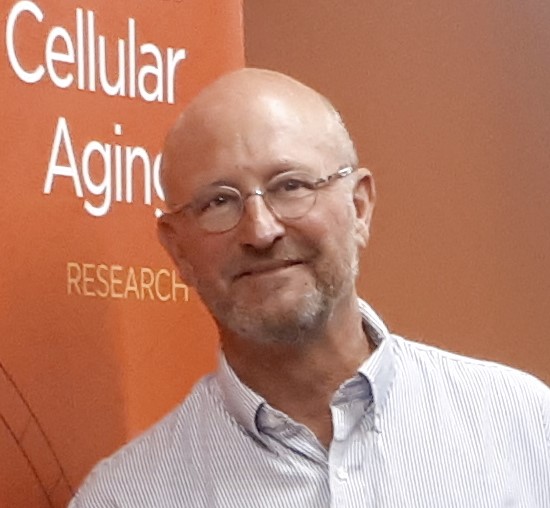Dr. Riabowol has studied biological aging in colonial algae (Simon Fraser University), mice (University of Southern California) and human fibroblasts (UAMS and Cold Spring Harbor Laboratory). His lab was established in the Heritage Medical Research Building in 1991 and his group studies the mechanisms that are critical for enforcing the state of cellular senescence in normal human cells and in both mouse and dog models of cellular aging. As former head, and a current member of the cancer group he also focuses on how mechanisms of aging are eluded during the processes of cancer cell immortalization and metastasis.
More specifically they examine the roles of telomeres, tumor suppressors and transcription factors in biological aging and tumorigenesis. They discovered that chronic viral infection accelerates aging of the immune system and identified one of the major mechanisms by which telomere length is regulated over time in the human population. This latter observation has significant consequences since their studies of canine telomeres also uncovered a very strong link between breed telomere length and lifespan, firmly linking cell aging to aging of the whole organism and so contributes to determining lifespan.
In looking for genes that affect cancer incidence they discovered a novel tumor suppressor we called ING1 for INhibitor of Growth that is intimately involved in both cell aging and the immortalization seen in most cancers. The five member ING gene family encode >15 proteins produced by alternative splicing and promoter usage that contain PHD domains that specifically recognize the H3K4Me3 histone mark of active transcription. Recognition of H3K4Me3 allows them to read the histone code and subsequently target either histone acetyltransferase (HAT) or histone deacetylase (HDAC) complexes to regulate local chromatin structure and gene expression.
They are currently developing a number of knockout models in different experimental systems to examine the contribution of telomeres to biological aging and the ING proteins to cell differentiation and aging. One very recent development in the lab is to determine the role of stem cell maintenance and differentiation that is impacted by one of the ING proteins, to regeneration and wound healing of various tissue types.
Academic Appointments:
- 2017-present: Full member, Robson DNA Sciences Centre
- 2015-present: Full member, Arnie Charbonneau Cancer Institute
- 2012-present: Full member, Alberta Children’s Hospital Research Institute
- 2010-2011: Acting Head, Department of Biochemistry & Molecular Biology
- 2009-2010: Vice-Director, Southern Alberta Cancer Research Institute
- 1999-present: Professor with Full Tenure, Departments of Biochemistry & Molecular Biology and Oncology, Cumming School of Medicine, University of Calgary, Calgary, Alberta, Canada
- 1997-2000: Chair, Cancer Biology Research Group, University of Calgary
- 1995-1999: Associate Professor with Contingent Tenure, University of Calgary
- 1994-1995: Assistant Professor, Oncology, University of Calgary
- 1992-present: Associate Member (Scientific), Tom Baker Cancer Centre, Calgary
- 1991-1995: Assistant Professor, Medical Biochemistry, University of Calgary
- 1989-1991: Staff Associate, Cold Spring Harbor Laboratory, Cold Spring Harbor, NY


